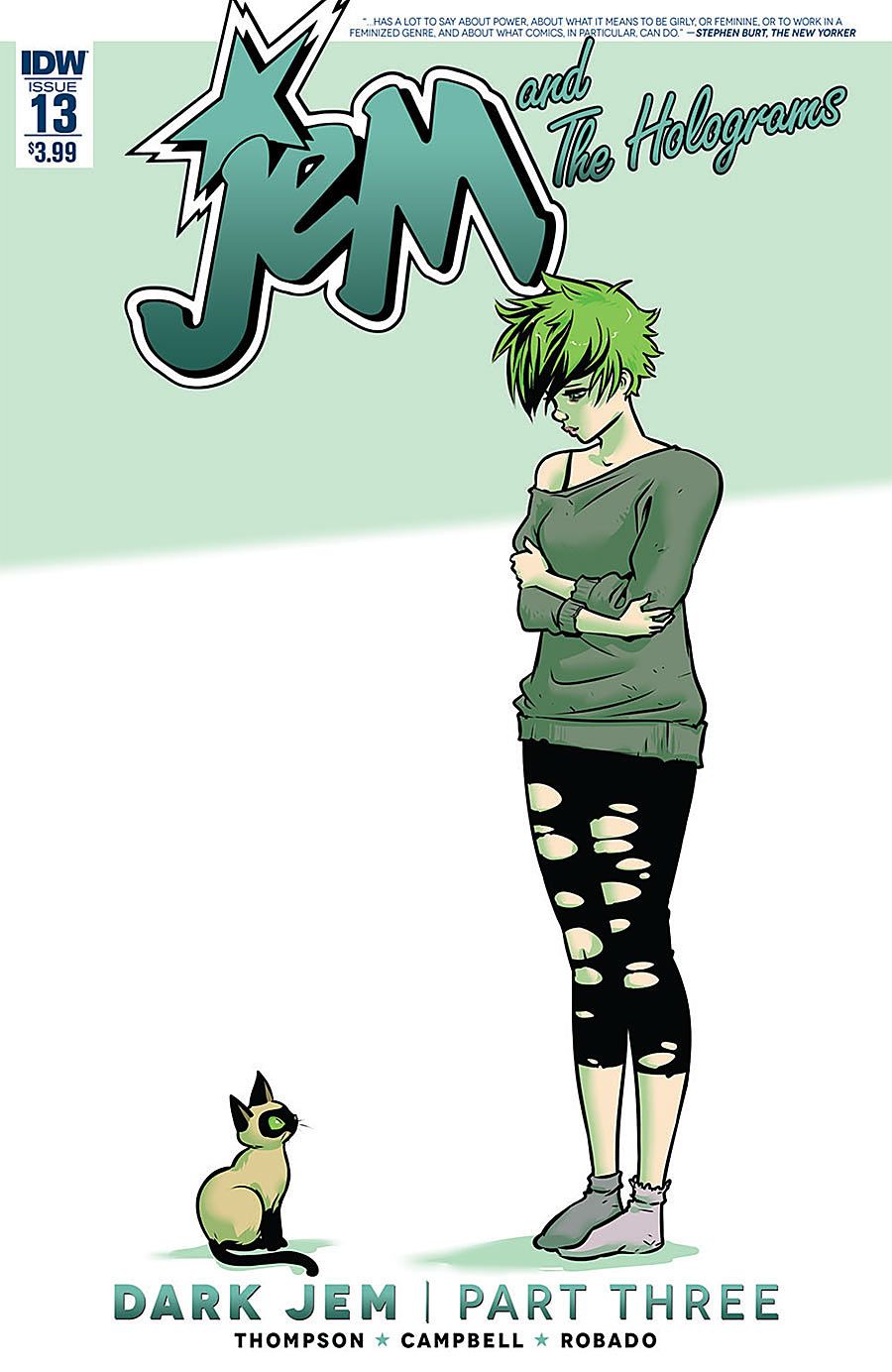Kelly Thompson and Sophie Campbell's "Jem and the Holograms" #13 opens with Blaze as she makes her on-stage debut with the Misfits. Even before the music begins, the artwork cements Blaze's social victory from the previous issue. The Misfits have embraced her as one of their own, and the opening page's progression of horizontal "war paint" profiles makes that clear. Using this scene as a launching point, Thompson and Campbell infuse the rest of the issue with similar energy and originality.
Thompson trusts Campbell's art and Shawn Lee's lettering carry a lot of storytelling, especially for the music scenes. Pizazz's voice had a spiky style, while the cursive script for Blaze indicates smoother, less aggressive vocals. In the same vein, Blaze's coral hair is on the opposite end of the color spectrum from Pizazz's chartreuse-green, but it's just as much of a contrast to the hair colors of the rest of the band. Visually, Campbell and Robado show Blaze fitting in, even before the singer thinks she's sufficiently proven herself.
The lyrics weave in and out of panels and intersect with the plot. The words "you still don't know what this is about" floats in a jagged line near Rio's puzzled face. Similarly, the line "we're torn up" hovers near Pizazz's face as she listens to her band play without her. Thompson and Campbell capitalize on opportunities that bind the music and the story more closely, so that music isn't merely furniture -- it's a source of plot.
The "Dark Jem" story arc has given Campbell the opportunity to experiment with the fashion and hair through Jem, Jerrica, Kimber, Shana and Aja. Her choices play to type in the goth rock vein (bored expressions, lots of black and metal studs, tattered hems) but are also delightfully imaginative (hair shapes, cracked glass textures).
The emotional climax of "Jem and The Holograms" #13 is the scene where Jerrica breaks out of the spell, and Thompson's script, Campbell's art and Robado's colors externalize an internal struggle. The scene is full of energy and originality. A wordless speech bubble conveys Jerrica's inarticulate distress and horror as she runs. Dark lightning bolts coated in pink and yellow outlines cut into each other, segueing into the panels in which Jerrica is shaken up and fragmented. The sequence of psychic distress culminates in a panel that looks part Cubist, part paint-spatter horror.
Just as effective -- but more conventional and subtle -- is the page that checks in with Pizazz. Once the loudest person in the room and the undisputed leader of the Misfits, she's been cut down by her accident and convalescence. Campbell's body language shows a subdued Pizazz, still proud and defiant but more brittle and fragile. Her admission that the Misfits sound great without her -- even if she says it aloud only to herself in a dark bedroom -- has pathos to it, perhaps because Pizazz is so competitive. Thompson's done a great job with the character. It was a smart move for Thompson to place Pizazz in adversity by cutting her off from music and her band. Who is Pizazz without the Misfits? She began as an amusing and one-dimensional diva, but now Pizazz commands more depth as well as more of the reader's sympathy than just about anyone else, with the possible exception of Stormer, who has suffered more in the star-crossed romance than Kimber.
Thompson and Campbell have focused pretty evenly on the two bands despite Jem and the Holograms' prime billing in the title, and the Misfits -- once the major antagonists -- have gradually evolved into something like co-protagonists. The reader roots for them as much as they do for Jem and the Holograms. The two bands may always be rivals, but "Dark Jem" pushes for them to work together, and the convergence may occur as early as next issue.
The humorous rescue is light-hearted and faintly ridiculous slapstick. It works fine as connective tissue, but it isn't as strong as the rest of the comic. The biggest weakness in the "Dark Jem" story arc, though, is the origin of the conflict. The unnamed force that has corrupted Synergy isn't a satisfying villain yet, because its limitations and motivations are unclear. What is it? What exactly does it do to people, and why does it want to spread itself like a disease? What does it symbolize, if anything? The answers aren't all there yet, but "Dark Jem" is already a successful arc for its leaps in characterization and visual energy.

